Historic Nottingham - Part 4 - Canal Walk (London Road
end)
w/e 20 May 2007
All this week's pictures were taken
with a Kodak DX6490
Our walk along the canal through this section of
"Historic Nottingham" began in Part 3 at Wilford Street
and now, to continue to London Road, we resume just past the
Magistrates' Court near the Carrington Street Bridge.
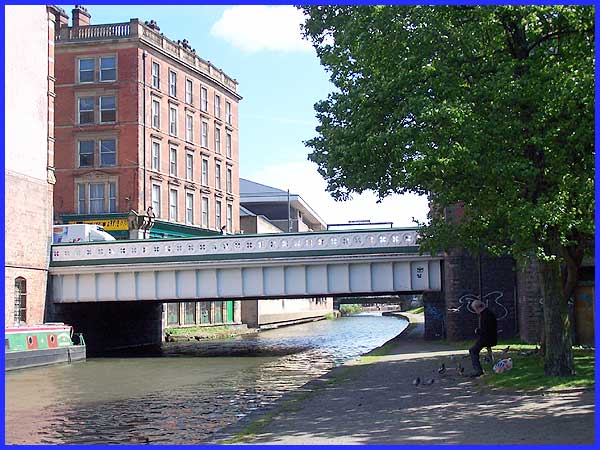
There is a copy of a sketch drawn by Thomas William Hammond dating
from 1901 on the Picture The Past site (search for NTGM013299)
showing a graceful arched bridge over the canal at Carrington
Street. Another photo on the same site (NTGM006901) from the
1920s and from a similar viewpoint shows that the graceful arch
had disappeared to be replaced by the girder bridge still to
be seen today. The Picture The Past site also contains a very
interesting biography of Mr. Hammond which I will summarise here.
He was born in 1854 in Philadelphia to parents who had emigrated
from Nottingham but was orphaned four years later and returned
with his younger sister to live in Nottingham with his grandparents.
At the age of 14 he enrolled in the Government School of Art
and, working as a lace curtain designer in 1871, was awarded
the 'Queen's Prize for a Design of a Lace Curtain' taking another
similar award in 1877 for a damask table cloth design. He also
used his skills as a draftsman to sketch about 350 charcoal pictures
of the changing town, exhibiting both locally and at the Royal
Academy. He died in 1935 but his work as an artist provides a
valuable record of Nottingham street scenes during his lifetime.
I'm sure if he were alive today he would still be busy sketching
as the changes in the city continue unabated but the buildings
on Carrington Street at this point appear to have changed little
from Tom Hammond's time.
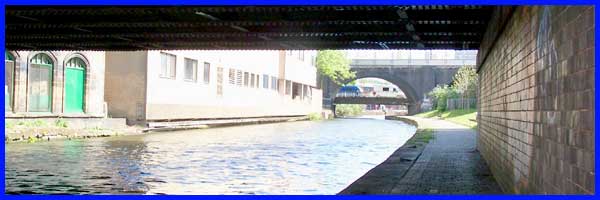
There is little headroom beneath the Carrington Street bridge
but as we pass under, we can see the next bridge at Trent Street
has a much greater clearance. Carrington Street itself has its
origins in 1829 when it was formed as an access to the railway
station that still stands on the south side of the canal.
|

Looking back after passing under the bridge, more impressive
architecture on Carrington Street is visible but my eye was caught
here by the number of bicycles, tyres and wheels in the windows
of the building opposite. I could not make out the brands but
they did bring to mind another industry that used to be major
employer in Nottingham and fully deserving of its place in history
- that of Raleigh Bicycles.
|
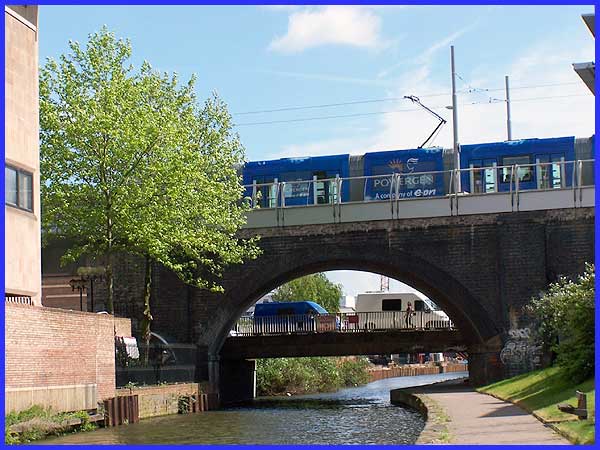
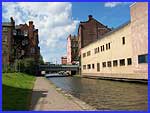  At Trent Street there are two bridges; the
higher former railway bridge now carries Nottingham's Light Transit
Railway (that's the tram to you and me) while the lower one is
for vehicle and pedestrian use. Between Carrington Street and
Trent Street the new Crown Courts back onto the canal (left)
and beyond Trent Street (right) are the offices of the multinational
credit card company, Capital One. At Trent Street there are two bridges; the
higher former railway bridge now carries Nottingham's Light Transit
Railway (that's the tram to you and me) while the lower one is
for vehicle and pedestrian use. Between Carrington Street and
Trent Street the new Crown Courts back onto the canal (left)
and beyond Trent Street (right) are the offices of the multinational
credit card company, Capital One.
|

Capital One (on the right above) on the site of the Boots (another
name synonymous with Nottingham's history) Printing Works is
just one of a number of large companies that are transforming
the eighteenth century canal into an area fit for the twenty
first century's business environment. Financial services, communications,
call centres and media are among today's buzzwords and other
hi-tech companies including NatWest and BT line the banks of
the canal.
|
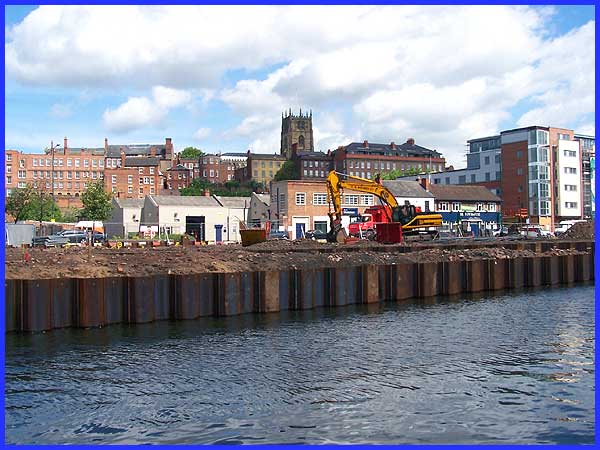
But the regeneration and redevelopment of what is fast becoming
known as the canal quarter is by no means complete and an area
on the north side of canal is currently being prepared for the
construction of more apartment blocks. Our walk will eventually
lead us into the Lace Market area of the city and until the apartments
are erected we can get a foretaste of that area in which the
tower of St Mary's Church is a prominent feature.
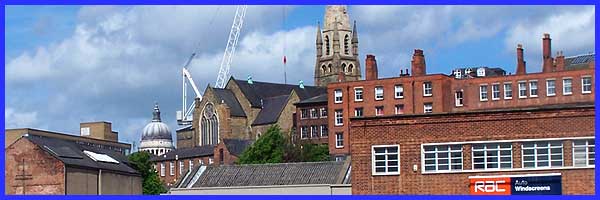
Also visible from this point as well as various other places
along the canal is the dome on the Council House building in
the Market Square, showing just how close we are to the city
centre. The dome reminiscent of that of St Paul's Cathedral in
London is reputed to surmount the largest council house in the
world. The crane is a temporay feature but testament to even
more redevelopment in the city.
|
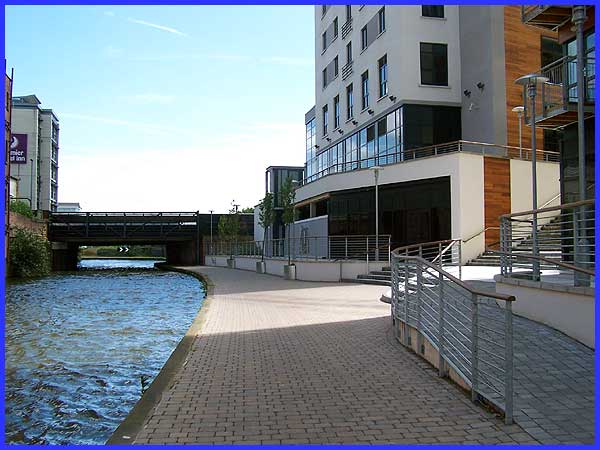
But as we press onward towards our goal, our route now is up
the steps on the right to wend our way around the Jurys Inn (a
hotel) and on to London Road. There we will turn left to cross
over the bridge we can see here crossing the canal. Beyond the
bridge is another hotel - the Holiday Inn which can also be seen
at the left of the image. The canal, however, after passing under
the bridge, makes a sharp turn to the right to follow London
Road southwards to connect with the River Trent. The entire length
of the Nottingham Canal had been completed by April 1796 but
by the latter part of the nineteenth century it found competition
with the railways and could no longer compete. It was finally
abandoned in 1937 and quickly fell into disrepair until Nottingham
City Council agreed to purchase the portion that came within
the city boundary in 1952. Now the regeneration of the area is
bringing it back to life and bringing enjoyment to all who use
it and its towpaths.
|

